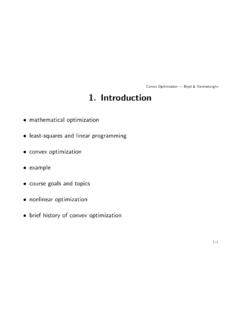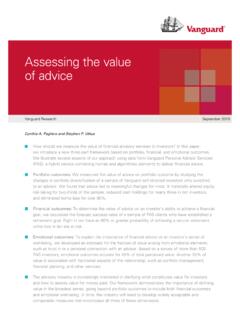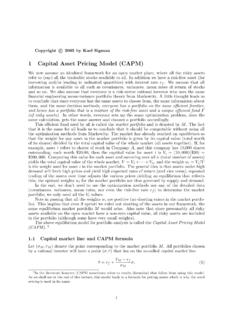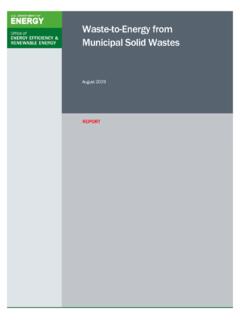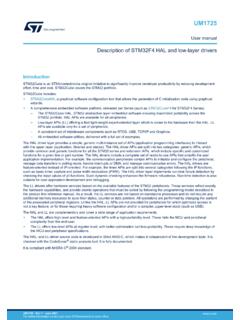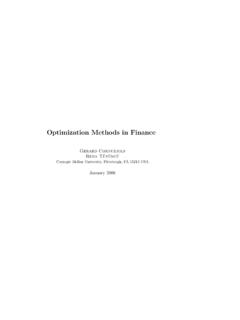Transcription of VaR vs CVaR in Risk Management and Optimization
1 Stan UryasevJoint presentation with Sergey Sarykalin, Gaia Serraino and Konstantin KalinchenkoRisk Management and Financial Engineering Lab, University of FloridaandAmerican Optimal DecisionsVaR vs CVaR in Risk Management and Optimization1 Agenda`Compare Value-at-Risk (VaR) and Conditional Value-at-Risk (CVaR)`definitions of VaRand CVaR`basic propertiesof VaR and CVaR`axiomatic definition of Riskand Deviation Measures`reasons affecting the choicebetween VaR and CVaR`risk Management / Optimization case studiesconducted with portfolio Safeguardpackage by Management `Risk Managementis a procedure for shapinga loss distribution`Value-at-Risk (VaR) and Conditional Value-at-Risk (CVaR) are popular function for measuring risk `The choice between VaR and CVaR is affected by:`differences in mathematical properties, `stabilityof statistical estimation, `simplicity of optimizationprocedures, `acceptance by regulators`Conclusionsfrom these properties are contradictive3 Risk Management `Key observations.
2 `CVaR has superior mathematical propertiesversus VaR`Risk Management with CVaRfunctions can be done veryefficiently`VaR does not controlscenarios exceeding VaR`CVaR accountsfor losses exceeding VaR`Deviationand Riskare different risk Management concepts`CVaR Deviationis a strong competitor tothe Standard Deviation4 VaR and CVaR Representation5xRiskVaRCVaRCVaR+CVaR-VaR , CVaR, CVaR+ and CVaR-6 Value-at-Risk`is non convexand discontinuousfunction of the confidence level for discrete distributions`is non-sub-additive `difficult to control/optimize for non-normal distributions: VaR has many extremumsfor discrete distributions7[1,0] })(|min{)( =zFzXVaRXfor)(XVaR X a loss random variable)(XVaR Conditional Value-at-Risk`Rockafellar and Uryasev, Optimization of Conditional Value-at-Risk , Journal of Risk, 2000 introduced the term Conditional Value-at-Risk`Forwhere8 + =)()(zzdFXCVaRX [1,0] <=)( when 1)()(n whe 0)(XVaRzzFXVaRzzFXX Conditional Value-at-Risk`CVaR+(Upper CVaR):expected value of X strictly exceeding VaR(also called Mean Excess Loss and Expected Shortfall)`CVaR-(Lower CVaR):expected value of Xweakly exceeding VaR(also called Tail VaR)Property: is weighted average of andzero for continuous distributions!
3 !!9)](|[)(XVaRXXEXCVaR >=+)(XCVaR ()CVaRX +()VaRX ()()(1 ())() if (())1()( ) if (( )) 1 XXXVaR XX CVaR XF VaR XCVaR XVaR XF VaR X + + < = = =1))(()(XVaRFXX)](|[)(XVaRXXEXCVaR = Conditional Value-at-Risk`Definitionon previous page is a major innovation`and for general loss distributions are discontinuous functions`CVaRis continuouswith respect to `CVaRis convexin X`VaR, CVaR-,CVaR+ may be non-convex `VaR CVaR- CVaR CVaR+10)(XCVaR+ )(XVaR xRiskVaRCVaRCVaR+CVaR-VaR, CVaR, CVaR+ and CVaR-11 CVaR: Discrete Distributions` does not split atoms: VaR < CVaR-< CVaR = CVaR+, = ( - )/(1- ) = 012124126636115622 Six scenarios,,CVaRCVaR =pppff ==== ===+L+ Probability CVaR 16 16 16 16 16 16 1f 2f 3f 4f 5f 6f VaR --CVaR +CVaRLossCVaR: Discrete Distributions splits the atom.
4 VaR < CVaR-< CVaR < CVaR+, = ( - )/(1- ) > 0 13711266121412245655555 Six scenarios,,CVaRVaRCVaR = === = ==+++Lpppfff+ Probability CVaR 16 16 16 16 112 16 16 1f 2f 3f 4f 5f 6f VaR --CVaR +115622 CVaR+=ffLossCVaR: Discrete Distributions splits the last atom: VaR = CVaR-= CVaR , CVaR+ is not defined, = ( - )/(1- ) > 014 CVaR: Equivalent Definitions`Pflugdefines CVaR via an Optimization problem, as in Rockafellar and Uryasev (2000)`Acerbishowed that CVaR is equivalent to Expected Shortfall defined by15 Pflug, , Some Remarks on the Value-at-Risk and on the Conditional Value-at-Risk , Probabilistic Constrained Optimization : Methodology and Applications, (Uryasev ed), Kluwer, 2000 Acerbi, C.
5 , Spectral Measures of Risk: a coherent representation of subjective risk aversion , JBF, 2002 RISK Management : INSURANCEA ccident lostPaymentAccident lostPaymentPremiumDeductiblePaymentPDF PaymentPDF PremiumDeductibleTWO CONCEPTS OF RISK Risk as a possible lossMinimum amount of cash to be added to make a portfolio (or project) sufficiently safeExample 1. MaxLoss - Three equally probable outcomes, { -4, 2, 5 }; MaxLoss = -4; Risk = 4- Three equally probable outcomes, { 0, 6, 9 }; MaxLoss = 0; Risk = 0 Risk as an uncertainty in outcomesSome measure of deviation in outcomesExample 2. Standard Deviation - Three equally probable outcomes, { 0, 6, 9 }; Standard Deviation > 0 Risk Measures: axiomatic definition`A functional is a coherent risk measure in the extended senseif: R1: for all constant CR2: for (convexity)R3: when (monotonicity)R4: when with (closedness)`A functional is a coherent risk measure in the basicsenseif it satisfies axioms R1, R2, R3, R4and R5:R5: for (positive homogeneity)18]0,1[ 'XX 0> `A functional is an averse risk measure in the extended senseif it satisfies axioms R1, R2, R4and R6:R6.
6 For all nonconstant X (aversity)`A functional is an averse risk measure in the basic senseif it satisfies axioms R1, R2, R4, R6and R5`Aversity has the interpretation that the risk of loss in a nonconstant random variable X cannot be acceptable unless EX<0`R2 + R5 (subadditivity)19 Risk Measures: axiomatic definition`Examples of coherentrisk measures:`A`Z `Examples of risk measures not coherent:`, >0, violates R3 (monotonicity)`violates subadditivity`is a coherentmeasure of risk in the basic sense andit is an aversemeasure of risk !!!`Averse measure of risk might not be coherent, a coherent measure might not be averse20 Risk Measures: axiomatic definitionA functional is called a deviation measure in the extended senseif it satisfies:D1: for constant C, but for nonconstant XD2: for (convexity)D3: when with (closedness)A functional is called a deviation measure in the basic senseif it satisfies axioms D1,D2, D3and D4:D4: (positive homogeneity)A deviation measure in extended or basic sense is also coherentif it additionally satisfies D5:D5.
7 (upper range boundedness)21 Deviation Measures: axiomatic definition[1,0] `Examples of deviation measures in the basic sense:`Standard Deviation`Standard Semideviations`Mean Absolute Deviation` -Value-at-Risk Deviation measure:` -VaR Dev does not satisfy convexity axiom D2 it is not a deviation measure` -Conditional Value-at-Risk Deviation measure:22 Deviation Measures: axiomatic definitionCoherent deviation measure in basic sense !!!23 Deviation Measures: axiomatic definition`CVaR Deviation Measure is a coherent deviation measure in the basic sense`Rockafellar et al. (2006) showed the existence of a one-to-one correspondencebetween deviation measures in the extended sense and averse risk measures in the extended sense:24 Risk vs Deviation MeasuresRockafellar, , Uryasev, S.
8 , Zabarankin, M., Optimality conditions in portfolio analysis with general deviation measures , Mathematical Programming, 200625 Risk vs Deviation MeasuresDeviation MeasureCounterpart Risk Measurewhere26 Chance and VaR Constraints`Let be some random loss function. `By definition: `Then the following holds:`In general is x,( , discrete distributions)`may be nonconvex constraintsmixfi,..1 ),,(= }}),(Pr{:min{)( =xfxVaR )(VaR }),(Pr{Xxf)(xVaR }),(Pr{ and )(VaR xfX27 VaR vs CVaR in Optimization `VaRis difficult to optimize numericallywhen losses are not normally distributed`PSG package allows VaR Optimization `In optimizationmodeling, CVaR is superior to VaR:`For elliptical distribution minimizing VaR, CVaR or Variance is equivalent`CVaR can be expressed as a minimization formula(Rockafellar and Uryasev, 2000)`CVaR preserve convexity28 CVaR optimizationTheorem 1 2.
9 -VaR is a minimizerof F with respect to :3. -CVaRequals minimal value( ) of function F :),( xF()()VaR( , )( , )arg min( , )fxfxFx ==()CVaR( , )min( , )fxF x =}]),({[11),(+ += xfExF29 CVaR Optimization `Preservation of convexity: if f(x, )is convex in xthen is convex in x`If f(x, )is convex in xthen is convex inx and ``Iff(x*, *) minimizes over then `is equivalentto )(XCVaR ),( xF X30 CVaR Optimization `In the case of discrete distributions:`The constraint can be replaced by a system of inequalities introducing additional variables k: ),(xFN1,..,k ,0),( ,0= kkkyxf + =Nkkkp11111(, )(1 )[ (, ) ]max { , 0}NkkkFxp fxzz +=+=+ = 31 Generalized Regression Problem`Approximate random variable by random variables`Error measure satisfies axiomsY12.
10 ,.nXXXR ockafellar, R. T., Uryasev, S. and M. Zabarankin: Risk Tuning with Generalized Linear Regression , accepted for publication in Mathematics of Operations Research, 2008 Error, Deviation, Statistic32`For an error measure :`the corresponding deviation measure is`the corresponding statistic isTheorem: Separation Principle`General regression problemis equivalent to33 Percentile Regression and CVaR Deviation34 Koenker, R., Bassett, G. Regression quantiles. Econometrica 46, 33 50 (1978)()1min[](1) []()CREXCEXCCVaRXEX + + = 35 Stability of Estimation`VaR and CVaR with same confidence level measure different parts of the distribution`For a specific distribution the confidence levels 1and 2for comparison of VaR and CVaR should be found from the equation`Yamai and Yoshiba (2002), for the same confidence level:`VaR estimatorsare more stablethan CVaR estimators`The difference is more prominent for fat-tailed distributions`Larger sample sizes increase accuracy of CVaR estimation`More research neededto compare stability of estimators for the same part of the distribution.


